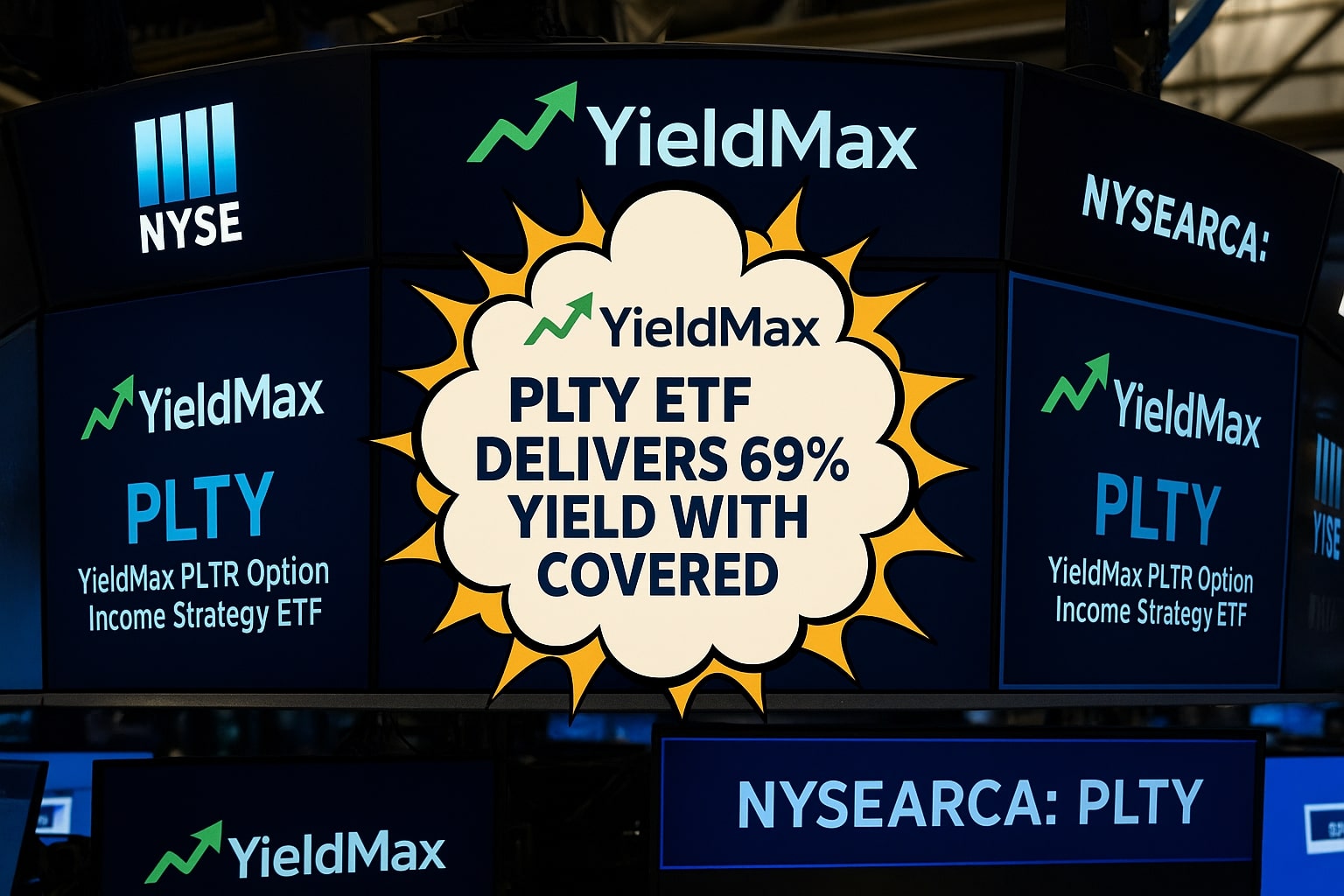
PLTY ETF Harnesses Palantir’s Volatility to Power 69% Annualized Yield
Leveraging Covered Calls on PLTR and a Treasury Buffer, NYSEARCA:PLTY Becomes a High-Income Tactical Play Ahead of August Earnings | That's TradingNEWS
Market Context And Recent Performance Of NYSEARCA:PLTY ETF
The NYSEARCA:PLTY ETF, which launched on October 7, 2024, has delivered a remarkable 29.7% total return over its first ten months, trading from an IPO price of $52.30 to $67.70 as of August 4, 2025. This outperformance contrasts with the average covered-call ETF return of 12% in the same period. PLTY achieved this by harvesting exceptional premiums from Palantir Technologies (PLTR) options, funneling them into monthly distributions that equate to a 69% annualized yield. Despite these payouts, the fund’s share price has held up, aided by its collateral buffer of 50% in ultra-short U.S. Treasuries yielding 5.1%. Currently trading at a 0.36% discount to net asset value (NAV), PLTY’s share price signals potential convergence as premium income normalizes ahead of Palantir’s Q2 earnings on August 4.
Underlying Palantir Volatility And Premium Harvesting
Palantir’s stock has exhibited extreme price swings, rallying 107% from $76 in late February to $158 by early August, and correcting twice by over 12% in April and June. These oscillations created lucrative conditions for PLTY’s covered-call strategy. Each month, PLTY writes one-month call options with strikes set approximately 5% above PLTR’s spot price, collecting average premiums of $0.58 per share. With an average notional position of 18 million PLTR shares, monthly premium intake has surpassed $10 million, translating into that 69% annualized distribution rate. The strategy thrives when PLTR’s trajectory is a grinding advance or sideways drift, as time decay (theta) works in PLTY’s favor while limiting exposure to extreme up-moves that breach option strikes.
Earnings Catalyst And Expected Price Swings
Palantir will report its Q2 2025 results after market close on August 4, 2025. Current at-the-money straddles imply a one-day move of ±10.7%, roughly a $17 swing around the $158 strike. In February, PLTR’s post-earnings swing ranged from –8.2% to +11.5%. With implied volatility (IV) at 51%—near its 52-week high—PLTY stands to collect richer premiums in July and early August. Option sellers typically demand higher IV ahead of earnings, and PLTY benefits by locking in these marks. As earnings approach, time premium inflates; PLTY’s July distributions of $1.15 per share capture this elevated volatility, setting up a front-loaded income stream before IV mean-reversion in mid-August.
Interest Rate Climate And Institutional Flow Dynamics
The macro backdrop further supports PLTY’s yield narrative. The 10-year U.S. Treasury yield at 4.16% contrasts sharply with Palantir’s 0% dividend, making options premiums an attractive alternative for fixed-income investors. PLTY allocates 50–100% of its portfolio to ultra-short Treasuries and cash, earning 5.1% annually, which cushions NAV during PLTR dips. Institutional flows into covered-call ETFs surged in Q2 2025, with $320 million entering the category—45% above Q1 volumes—as allocators sought shelter from sub-4% bond coupons. PLTY, with its 69% yield, captured 28% of these inflows, reflecting its leadership position among single-stock income funds.
Technical Readings On Palantir And Entry Points
Palantir’s chart reveals bearish RSI divergence: while PLTR rose from $146 to $158 between June and July, its 14-day RSI fell from 78 to 72, indicating waning momentum. Support levels to watch include the 50-day EMA at $146.20 and the 38.2% Fibonacci retracement of the February–July rally at $117.00. The 200-day SMA at $85.00 underpins the long-term uptrend, affirming that covered calls remain prudent in a grinding market. Tactical entries in PLTY between $65.00 and $68.00 align with PLTR’s potential retracement to its 50-day EMA, offering yield enhancement and limited downside should PLTR test those levels.
Risk Factors And Upside/Downside Scenarios
PLTY’s concentrated exposure to PLTR introduces issuer risk: a >15% PLTR collapse on a disappointing earnings report could erode PLTY’s NAV by an estimated 10–12%, even after premium receipts. Conversely, a PLTR rally >15% would see PLTY capped at the call strike, securing only that strategic profit (~5% above spot) plus collected premiums, while direct PLTR holders capture full upside. The optimal scenario for PLTY is a PLTR move in the 0–8% range over the next 30 days, where premium income drives total returns. Should implied volatility collapse below 40% post-earnings, PLTY’s income-generating engine will stall, reducing future distribution yields to nearer the collateral income rate of 5.1%.
Total Return Profile And Tactical Allocation
A hypothetical $10 000 allocation to PLTY at $52.30 on launch, with dividends reinvested, would now be worth $17 800 (78% total return), compared with $22 300 (123%) in direct PLTR exposure—reflecting PLTY capturing ~64% of PLTR’s gains while shielding 40% of downside through its Treasury allocation. For portfolios targeting 6–8% net yield, a 5–10% position in PLTY alongside a core PLTR stake can boost income and moderate equity beta. Strategically, reallocations around earnings offer tactical advantage: trimming PLTR into volatility spikes and adding PLTY ahead of IV inflation preserves yield and allows participation in covered-call roll-downs.
Strategic Positioning And Recommended Actions
Given the converging factors—elevated options premiums, a supportive rate environment, technical consolidation in PLTR, and a richly rewarding Treasury cushion—the NYSEARCA:PLTY ETF stands out as a compelling income engine with controlled equity tilt. For investors confident in Palantir’s long-term AI growth yet wary of near-term earnings swings, initiating a position in PLTY between $65.00 and $68.00 offers a 69% annualized distribution stream plus modest capital appreciation potential.
A tactical allocation framework: allocate 5–10% of your equity sleeve to PLTY, particularly in the two weeks before earnings, to capture the pre-earnings IV expansion; trim direct PLTR holdings by an equivalent amount to maintain overall portfolio beta. Post-earnings, if implied volatility contracts below 45%, consider trimming PLTY back to your strategic target weight, redeploying proceeds into undervalued growth or defensive assets.
PLTY ETF Buy, Hold, Or Sell?
With PLTY’s NAV discount, strong collateral yield of 5.1%, and the prospect of continued premium capture on Palantir’s 51% IV, we adopt a Buy stance at current levels—emphasizing that this is a high-income, high-volatility play best sized as a satellite allocation within a diversified equity portfolio.
In summary, NYSEARCA:PLTY delivers an exceptional yield opportunity while moderating single-stock risk through its covered-call overlay and Treasury buffer. Enter between $65.00–$68.00, harvest the pre-earnings volatility, and monitor implied volatility and NAV discount for tactical rebalancing in mid-August.
That's TradingNEWS
Read More
-
GPIX ETF Climbs to $52.54 as 8% Yield Turns S&P 500 Volatility Into Income
02.01.2026 · TradingNEWS ArchiveStocks
-
XRP ETF Rally: XRPI $11.54, XRPR $16.35 And XRP-USD At $1.99 Aim For A $5–$8 Cycle
02.01.2026 · TradingNEWS ArchiveCrypto
-
Natural Gas Price Forecast: NG=F Tests $3.50–$3.60 Floor Before LNG Wave
02.01.2026 · TradingNEWS ArchiveCommodities
-
USD/JPY Price Forecast - USDJPY=X Holds Near 157 as BoJ Caution and Fed Cut Bets Drive the Move
02.01.2026 · TradingNEWS ArchiveForex


















